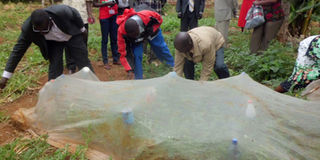Understanding bees link to higher yields

Far left, a sample of bees species in a laboratory. Left, an on-farm demonstration of how vital bees are to crop production. PHOTO SBY LOMINDA AFEDRARU.
What you need to know:
In Kenya, a research has been going on whose findings would be of interest to Ugandan scientists and farmers.
For crops that require pollination, insects such as bees are a necessity in their growth cycle. This is especially necessary for fruit crops that have both female male and flowers, where the pollen must be moved by bees and other insects. One such crop is water melon, which if not left open for the insects may not fruit.
Scientists at Kenya Agricultural and Livestock Research Organisation (KALRO) have been conducting a study on bee species, which can help pollinate water melon and other fruit crops.
KALRO, through the Kenya Pollination Project, has been training farmers at Kilimambogo, Kakamega, Laikipia and Meru to understand pollinators, pollination needs of their preferred crops and how to manage and increase pollinators in their farms.
This has been going on since 2010 and the project is ending this year.
In addition, KALRO has been conducting research on-farm and on-station at Kabete to understand pollination needs of crops and identify best pollinators for greenhouse crops.
Dr Muo Kasina, a senior research officer in charge of pollination and pest management at KALRO, says his team collects different bee species from different parts of Kenya to study their behaviour in as far as pollinating crops is concerned.
Best pollinators
He categorises them as carpenter and honey bees. The former concentrate in making their shelter but do not make honey like honey bees, so they do not pollinate crops. They are also wild solitary bees that live independently, and not in colonies like honey bees, while the latter pollinate crops. As such, honey bees are the best pollinators because they are looking for flowers to make honey.
Dr Kasina points out that since sweet melons are vulnerable in making their own pollen for fertilisation to take place, his team has opted to use it for the study.
Farmers have been relying on crop rotation practices, where they switch water melon with crops such as onions and tomatoes but this does not work well. However, the scientists, using solitary and honey bees in their study, have discovered the latter worked well in the pollination exercise. This was in trainings conducted with 500 farmers in the different villages in Kenya. In these training, they showed them on how to attract bees into their water melon fields.
Mr Eric Mudama, the field trial manager at Kilimabogo, explains that the farmers are tasked to cover part of the crop with a polythene paper to prevent the bees from reaching that part but to keep watering the whole field, which attracts the bees.
The section, which is covered, will fail to fruit because pollination has not taken place but there will be a lot of fruiting in the part of the field that is exposed to the bees, thus giving good yields.
On a visit by science journalists to her farm, courtesy of Media for Environment, Health and Agriculture (Mesha) and African Agricultural Technology Foundation (AATF), Naomi Gathogo Njuguna, a beneficiary farmer, demonstrated that the covered part will produce some fruit because of the presence of some butterflies. These may manage to escape into the covered part but still the fruit ends up being aborted.
Observe good practices
But the fruit from the uncovered part of the field is sweet with a red colour because pollination by honey bees. The farmers are also advised to restrict pesticide use to the minimum because increased quantities discourage the bees from flying to and around the field.
The farmers should control pest infestation mainly by observing good agronomic practices such as weeding frequently, mulching as well as crop rotation.
Water melon farming in Kenya has not been appreciated by farmers but with the training they have obtained from the scientists, many are now venturing into it because they think it is economically viable.
Similarly, in Uganda, from this research, there is a lot to draw from by both farmers and scientists on the importance of bees and pollination to farm yields.
About pollination
Pollination is an ecosystem service provided largely by bees estimated at 85 per cent in agriculture and it directly contributes to more than 40 per cent of the net gains from growing crops dependent on pollinators for fruit and seed.
In East Africa, farmers do not manage pollinators, and pollination is not mainstreamed in agriculture as an important input of crop production. The agriculture sector is currently faced with declining pollinators as a result of various factors. One is habitat loss that would otherwise provide food and shelter for the pollinators.
There is also climate change that impacts on food provision for pollinators and increasing their vulnerability to life-threatening stressors as well as lack of awareness about their importance, which prevents farmers from protecting them and governments from mainstreaming them as key input of crop production, among other stakeholders.
Pollinators are essential for production of quality seeds especially vegetables, oil crops and fodder crops. Some crops such as Lucerne, also known as Alfalfa, will not produce viable seeds without cross-pollination.
Well-pollinated fruits are sweet and juicy and legumes have higher protein content when cross-pollinated by bees.




